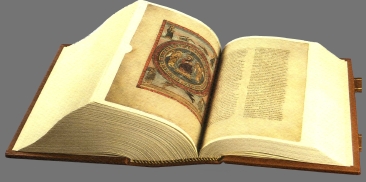| | Ceolfrith, abbot of the twin monasteries of Weamouth and Jarrow in Northumbria, had three copies of the Bible made from a model coming from Cassiodorus' Vivarium. Of these only the Codex Amiatinus (ms. Laur. Amiat. 1) survives intact today. This manuscript, written between the end of the 7th and the beginning of the 8th centuries by at least seven or eight scribes, is exceptionally large. It is composed of 1029 parchment leaves, measures 34.5 x 54 cm and weighs around 50 kilos. Its extraordinary interest derives not only from these external characteristics, but also because it is the most ancient and complete witness to the Vulgate Latin Bible. The Codex Amiatinus was carried to Rome by Ceolfrith as a gift to Pope Gregory II in 716. At an undetermined date, though certainly before the beginning of the 11th century, the manuscript came to the Monastery of San Salvatore on Mount Amiata, where it remained for a least seven centuries, except for a brief period in Rome when it was collated by the commission in charge of the Sistine Bible (1590). Kept in the reliquary cupboard of the Amiatine monastery, it fell victim to the Suppression of the Monasteries ordered by Grand Duke Leopold and was confiscated in 1782. Two years later it was assigned to the Laurentian Library where first the Medicis and then the House of Lorena hoarded the most important witness of Western culture in their possession. The imposing structure of this manuscript, its venerable age and the value of its great miniatures (of which the most famous is that portraying Erza copying the Holy Scriptures) have ensured its strict conservation. Thus, the manuscript is still in excellent condition. These same features have, however, made consulting or exhibiting the manuscript extremely difficult as well as carrying out its accurate reproduction. Only the most modern techniques and help from various private and public entities have made it possible to offer a series of "copies" of the Bible which could satisfy the requirements imposed by scientific research. The manuscript, after being unbound, has been reproduced on a series of negatives, which have been used at first for making a replica of the same dimensions (donated to the Abbey of San Salvatore for its museum), and then several smaller facsimiles for sale to libraries and individuals, allowing for a more widespread range of research, from the most simple to the most complex. During these phases of the reproduction, carried out in the Laurentian Library, scholars from various disciplines and of different nationalities have been able to study the original | |
La
Bibbia Amiatina Florence, Bibliotheca Medicea Laurentiana, "Amiatino 1" Complete reproduction of the manuscript  Deluxe facsimile edition by Le Meta Editore, Florence. Edition of 199 copies. 24 x 33.5 cm Price on request. _________________________ and deepen their codicological, liturgical, musicological, and art history research. Scientific analyses have been made of the colors of the miniatures as well. With the collaboration of various professionals, from librarians to restorers, from biologists to chemists, research has been carried out with results contributing to the understanding of the codex, especially in regard to the vexing question of the ordering of the leaves belonging to the first gathering. In fact, it has been discovered that these folios were arranged in a sequence different than the one known until now. The "new" ordering corresponds to the one the leaves have had for the longest period of time until the manuscript's rebinding before 1784, the year in which it was fully described by the Laurentian Librarian Angelo Maria Bandini. This arrangement is carefully followed in the reduced-size facsimile. (Franco Arduini) _________________________ OMI - Old Manuscripts & Incunabula PO Box 6019 FDR Station New York NY 10150 tel/fax 212/ 758-1946 http://www.omifacsimiles.com immels@earthlink.net |